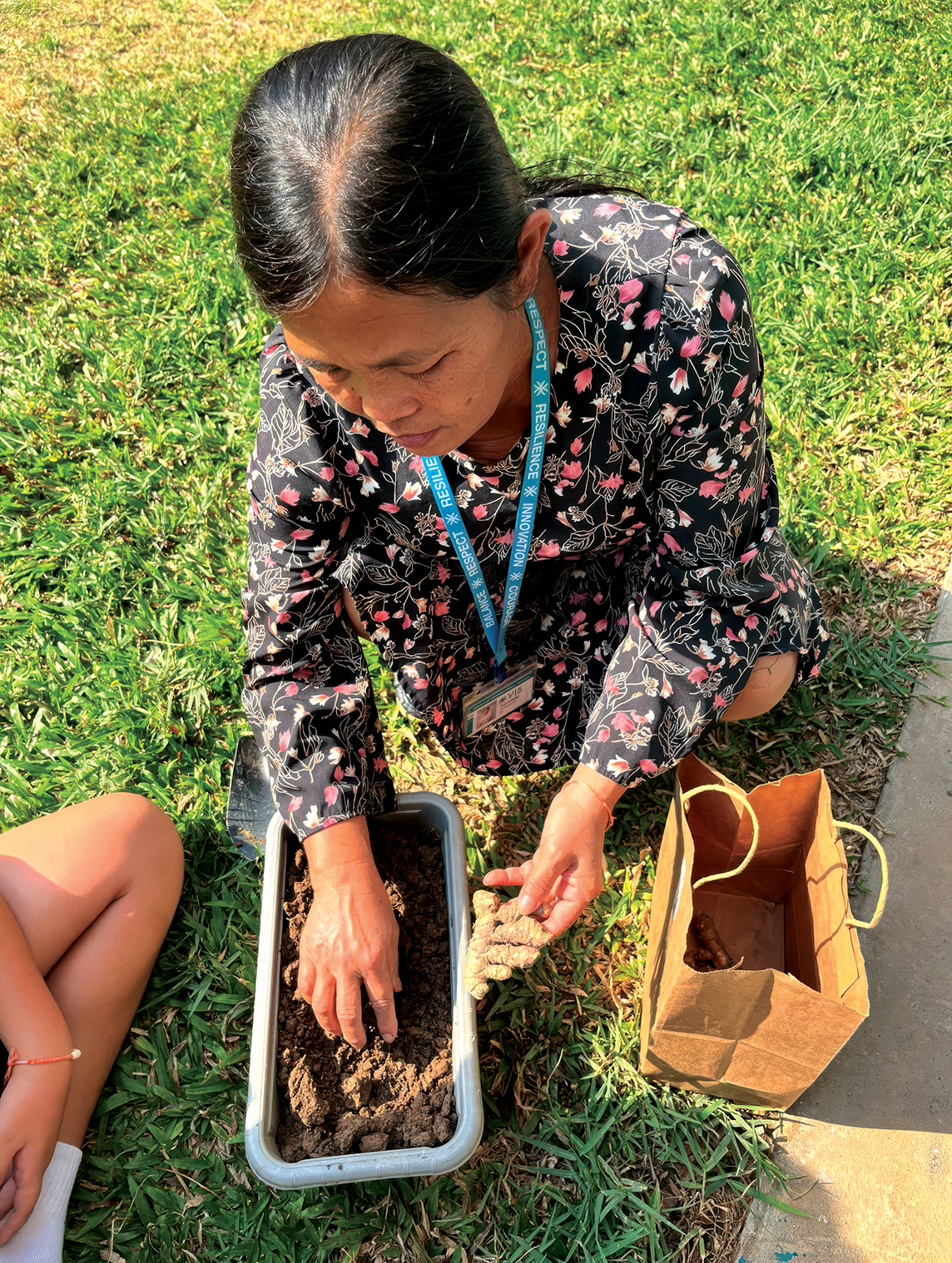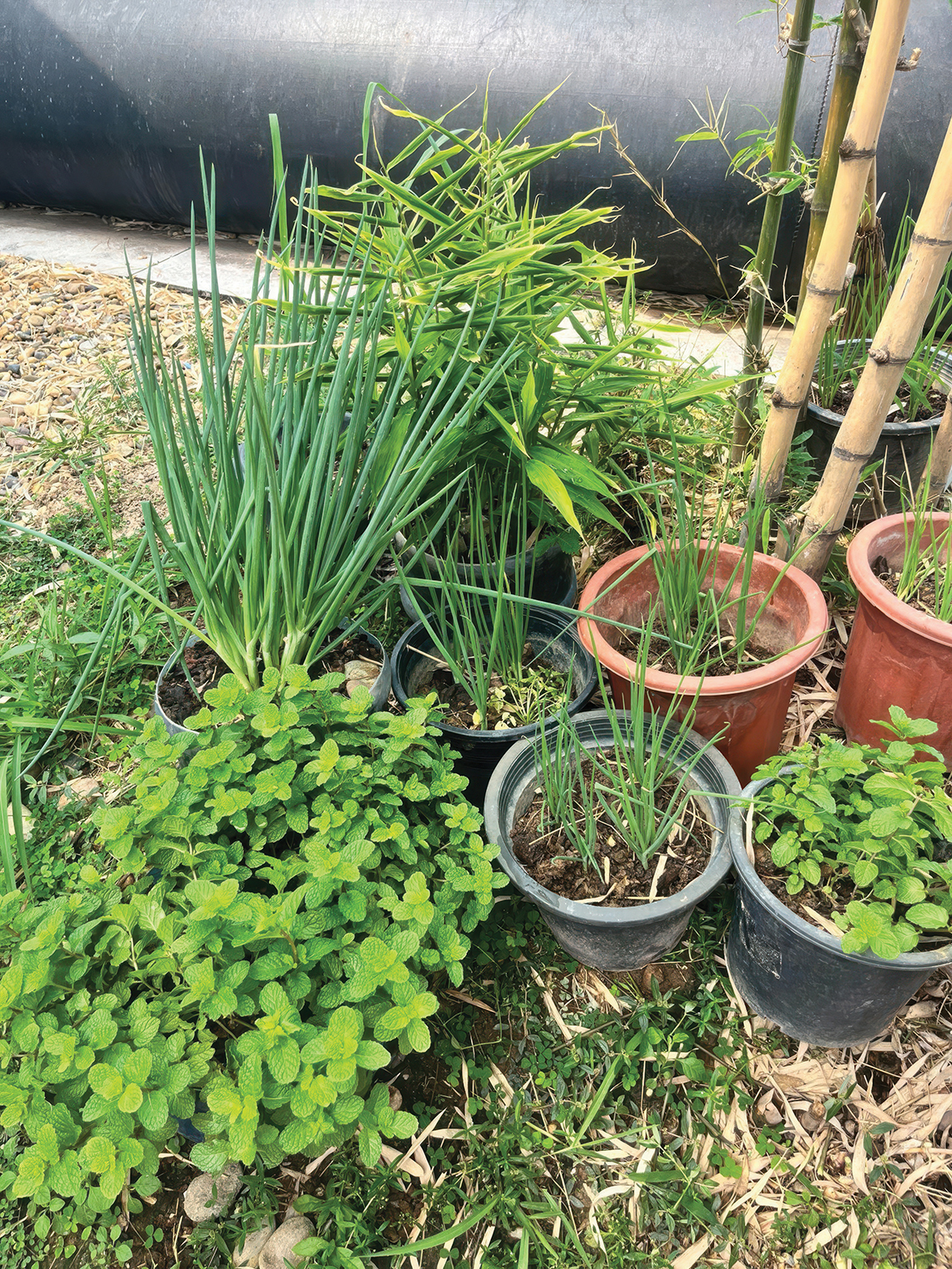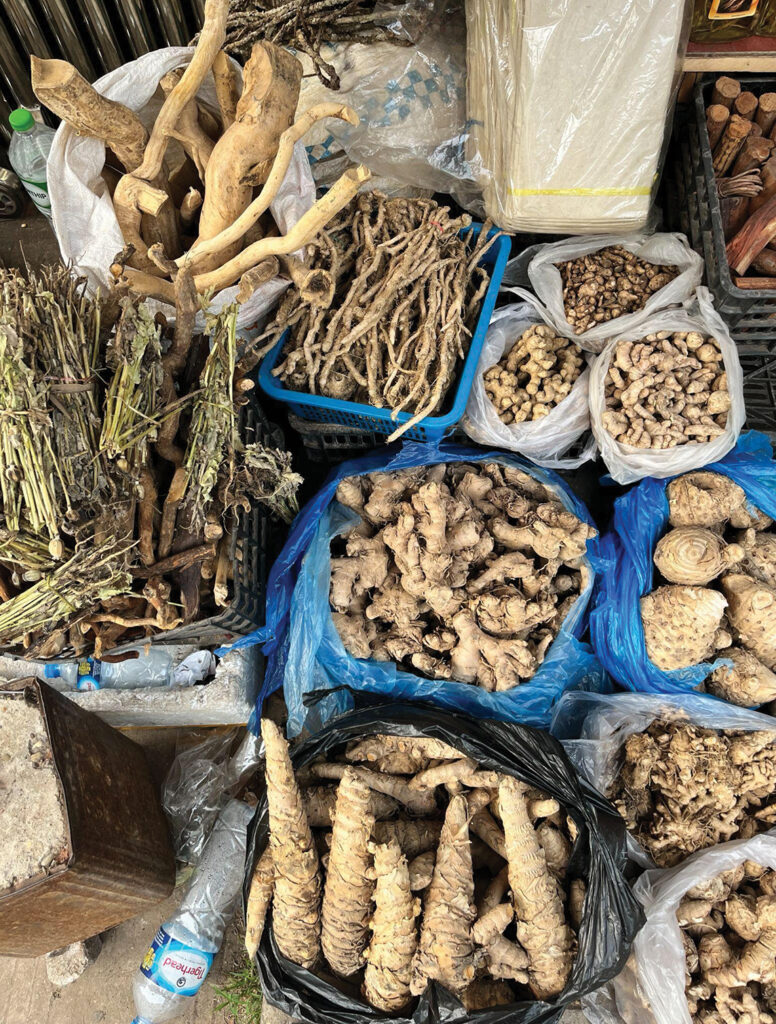The Power of Plants
Learning About Herbs and Indigenous Wisdom in Laos

People often ask me what one thing I would recommend to restore relationship between land and people. My answer is almost always “Plant a garden.” It’s good for the health of the Earth and it’s good for the health of people. A garden is a nursery for nurturing connection, the soil for cultivation of practical reverence. And its power goes far beyond the garden gate — once you develop a relationship with a little patch of earth, it becomes a seed itself. Something essential happens in a vegetable garden. It’s a place where if you can’t say “I love you” out loud, you can say it in seeds. And the land will reciprocate, in beans.
—Robin Wall Kimmerer, Braiding Sweetgrass: Indigenous Wisdom, Scientific Knowledge, and the Teachings of Plants
Last November, my students and I went on an experiential learning trip to the mountains in the north of Laos around Luang Prabang. One morning, we hiked through a Hmong (a local ethnic group) village in the jungle on the way to the Kuang Si waterfall. At the midway point, we stopped to take a break.
Our guide, a Hmong local named Kor, took out a machete and hacked a piece off a plant that looked like bamboo but wasn’t. Kor rubbed a bit on the inside of his wrist and said to the students, “This plant lets you know if you have dengue fever. If you rub it on your wrist and you have a reaction, it means you have dengue. If you don’t, it means your fever is just a fever. This plant is important because it lets us know what kind of illness we have, so we can treat it correctly.”
The students were fascinated, and so was I. In fact, when we got back to our classroom in Vientiane and reflected on the trip, the moment that the students remembered the most was this one.
Someone gave me a copy of Robin Wall Kimmerer’s Braiding Sweetgrass a few years ago. When they gave it to me, they said, “You know, so many Americans today have plant blindness. We fail to notice, recognize, or appreciate the presence and importance of plants in our environment.”
Growing up on Long Island, New York, I couldn’t have been more plant blind. I could tell you the names of five malls near my childhood home, but not the names of five native plant species in Nassau County.
I read the book immediately and loved it, especially the descriptions of the traditional relationship between Indigenous peoples and the plants around them. However, I forgot about the book in the hecticness of daily life. It sat on my shelf until I returned from the experiential learning trip, when I picked it up again. I thought to myself, I would like to know more about Indigenous wisdom, plants, and gardens. I took my 6-year-old son to the nursery, and we purchased some Thai chili pepper seeds. Did you know Thai chilies are a good source of vitamins A and C, antioxidants that can boost the immune system?
We planted the seeds in our backyard and, lo and behold, they grew. It was a small miracle. I felt pride and joy eating those peppers, especially knowing they were good for my health, too. I wanted to share that joy with my students.
Taking It to the Classroom
I am an international teacher living in Vientiane, Laos. Laos has a long history of using herbal medicines. You’d be hard-pressed to find anyone on the street who doesn’t have a jar of Tiger Balm (a topical pain relief product, often used for muscle and joint aches or bug bite relief) somewhere on their person. Sixty-two percent of the people here still live in the countryside, far from doctors and hospitals. The modern health care system may be “underdeveloped,” but traditional healing pathways are robust. Communities have, for generations, had to rely on themselves and their knowledge of herbal remedies when they are sick. This knowledge is passed down orally from grandparents to parents to children.
I work with an older Lao woman named Vanmany. I see her around school, throwing eggshells and bits of potato into the planter beds. She has a wealth of knowledge about local plants. Vanmany told me that she learned about plant medicine from her mother, who grew up in a village. I asked Vanmany if she would help me learn more about plant medicine in Laos. She walked me to a spot beside the school building near the fence, overgrown with what looked like weeds.
She pulled off a leaf from a plant. “You see this? You can rub this on a cut if you are bleeding. It’s a coagulant. It will stop the blood.”
Then she took me to a spot behind the canteen. There were small pots with all sorts of herbs growing — mint, basil, lemongrass.
“This is the cafeteria workers’ garden. They grow these plants to season and spice the food they cook for the students.” A cafeteria worker saw us looking and came out. She picked up the mint pot and gave it to me.
“Here, you take it,” she said. “It’s good for your tummy and it cures bad breath.”
I moved the mint plant outside of my classroom. The students went up to the plant and smelled it.
“Mmmm,” one said.
“It’s so green,” said another.
“Can I water it?” asked a third.
“Yes, yes, of course,” I said.
The care the students showed to that small mint plant was amazing.
I remembered the quote from Kimmerer, that gardens are a way to say “I love you” with seeds. So often in teaching, we are restrained from sharing strong emotions. We shy away from telling our students and our colleagues that we love them. Maybe it’s because our definition of love is usually limited to the romantic kind. I wondered if we could create a garden together as a way of expressing our love and care for each other.
“Would you like to grow some plants?” I asked the students. They replied that would be a good idea.

Some Background
The school I work at, Vientiane International School, is a K–12 nonprofit international school situated in Laos’ capital city. There are about 400 students — a multilingual, multi-ethnic group from more than 50 countries. They speak diverse home languages, including Chinese, Japanese, Korean, French, German, Lao, Thai, and English. Some are the children of embassy, U.N., World Bank, and aid workers. Other students are here because their families work in industries such as mining, banking, or hydropower. Others are the children of the Lao elite, their parents high-profile government and military officials and business owners. We follow the IB (International Baccalaureate) curriculum, and are the only IB continuum school in Laos. English is the language of instruction, and many of our students are English learners.
At our middle school, we emphasize inquiry-based learning. To foster critical thinking, creativity, and interdisciplinary learning, we offer six-week, immersive, elective classes. These elective classes run on Wednesdays in 2.5-hour blocks. They are capped at 20 students and are mixed-grade level, so students from grades 6 to 10 learn together.
Getting the Garden Started
After that conversation about the garden, I decided to offer an elective class, “The Power of Plants.” The class description said, “Explore the diversity of plants in Laos and learn why it’s important to protect them. We’ll discuss traditional uses of plants in Lao culture and create our own healing herbs garden. This is a great chance to understand how plants impact our lives and why preserving them matters. Sign up and discover the world of plants!” The class filled up immediately.
The truth is, I know nothing about plant medicine in Laos. I am an American visitor here. But I wanted to learn. And so did the students. I wanted us to, as Kimmerer said, “nurture connection.” I thought it would be best to learn from hearing stories from women and elders with expertise in the field. Along with a few others, Vanmany became our guide and our fount of knowledge.
We went on a field trip to the local morning market to see the Hmong women selling herbal medicines. Most of the stuff on the tables looked like roots, bark, seeds, and dried leaves.
“In America, you mostly just eat the fruit from the plant,” Vanmany said. “But here, we recognize that all parts of the plant are useful. Not just the parts that are sweet.”
We looked at all sorts of plants for a variety of purposes — some for headaches, some for stomachaches, some for inflammation, some for virility, some for women who are menstruating, some for women who are pregnant, etc. We bought morning glory and coriander seeds, turmeric, ginger, garlic, moringa, blood onion, holy basil, jujube, bael fruit, and others to bring back to school to study and grow.
Back at school, we planted the seeds and roots we had bought. Vanmany, in her soft-spoken way, showed us what to do. The students watched her break up the soil and mix it with manure. Some students jumped right in, starting to dig, and said that they had gardens at home. But it was clear that most students had never gardened before or spent much time outside of cities.
“Is that cow poo poo?” one student asked.
“Ewww,” another said.
“Actually,” said Vanmany, “this manure is very good for the soil. It makes it healthy, and it’s more natural than using fertilizer. It’s clean.”
The students took turns using the shovels and preparing the dirt. Some kids found sticks and made signs with the names of the plants we were going to grow. We were learning by doing and using our hands. It was nice to be outside in the sunshine and not in the classroom staring at computer screens. The students with limited English were able to participate fully because we were doing something without a lot of written language. When the class was over, one student said, “What? Is it time to go already? The class went fast.”

Learning About Plant Medicine
After we planted, I took out chart paper and asked students to brainstorm questions about plant medicine. They had lots of good ones:
- How did people find out about herbal medicine? Like in the very beginning.
- Did it take generations to know what something was?
- How was this knowledge passed down from person to person?
- In the past, there wasn’t testing or labs or computers to get information, so did people just eat stuff and see what it did to them?
I told the students I was going to add my own question to the brainstorming sheet: “In what ways do we need to consider different perspectives or step outside of our comfort zone when learning about local and global issues?”
The students were confused. They asked, “What do you mean?” I replied, “With this question, I want you to think carefully about whose voices you usually listen to when making health care decisions. I want you to understand that we often value the voices of Western doctors, medical professionals, and people with university degrees over the wisdom of people who have deeply rooted knowledge of their local communities. Why do we do that? What do we lose when we do that? Can we broaden our scope, include more voices, and thus broaden our understanding of what health is?”
Then, we did some online research. We found articles on traditional medicines in Laos; a website created by the University of Chicago cataloging plant medicine in Laos; and a short film by a medical anthropologist who had conducted ethnographic fieldwork on plant medicine and shamanism in the countryside.
I contacted the anthropologist to see if she’d be willing to meet up. She wasn’t living in the country anymore, but put me in touch with Dr. Chiobouaphong Phakeovilay, the deputy head of the Department of Traditional Medicines at the University of Health Science in Vientiane.
I arranged for the professor to visit our class. The students were excited, brainstorming questions they could ask her:
- Which herbal plants are the best for us?
- If we could add only one herb or plant to our diet, which should we add and why?
- How do you prepare the plant medicine for giving to people?
- Where do you find the plants?
- How do you know which plant is which?
I also invited our school nurse, Moe Moe, originally from Burma, to speak to the students, as she used to do aid work as a midwife in rural Laos.

Seeds and Ideas Taking Root
When Nurse Moe Moe came, she brought some plant samples from her home garden. She told us about the plants that she regularly uses for common ailments. Moe Moe told us that, of her three children, all adults now, only one had ever taken an antibiotic. She also shared how she used a combination of healing plants to keep her immune system strong when she was undergoing chemotherapy treatments for breast cancer.
Moe Moe said, “It’s not one or the other — modern medicine or traditional medicine. It’s best to have a combination of both. We place so much value on pills and quick fixes. Plant medicine is slow. But it’s also useful.”
I wanted to teach into this. “Remember what I told you about understanding different perspectives,” I said to the students. “It’s not either/or. It’s not a binary. One is not right and the other wrong. It’s better to keep the mindset of both/and.”
Moe Moe distributed samples of lemongrass for the students to try. “Lemongrass is a powerful anti-inflammatory and antioxidant,” she said. “You can put it in soup.”
Moe Moe also passed around neem leaves (good for lowering blood pressure), homemade turmeric powder (anti-inflammatory), and moringa leaves (contains about as much potassium as a banana, about the same amount of vitamin C as an orange, and has calcium, protein, iron, and amino acids, which help your body heal and build muscle). The students were jumping out of their seats with excitement to try the different herbs.
“Ohhh! The neem is bitter! It’s so spicy. Aaaah!!”
“The turmeric made me sneeze.”
“My mom uses this one when she’s cooking chicken.”
“I had this in an Indian restaurant one time . . .”
“Will this make me smarter?”
“We call this something else in Mandarin.”
“This one is popular in Korea, too.”
The students made connections, shared ideas, and asked questions. They were also bringing in elements of their cultures and backgrounds. It felt like we were a true learning community, exploring together. I remembered another line from Kimmerer: “[The garden’s] power goes far beyond the garden gate.” Here we were, people of varying ages and nationalities, exploring together the uses of plants. It was a joyful class.
A few weeks later, Dr. Phakeovilay came to visit. She grew up in a small village in the south of Laos, where plant medicine is commonly used. Dr. Phakeovilay showed us herbarium samples she had collected and explained how to use a key to identify plant species. She also talked about her doctoral research into the medicinal properties of the guava plant. She told us that guava leaves have many uses — including treating dengue fever and reducing inflammation. She stressed the importance of knowing the local flora where you live and in places you visit.
Dr. Phakeovilay showed us pictures of her laboratory and explained how she and her students create powders and tinctures for pharmaceuticals out of plant parts. Dr. Phakeovilay said that recent studies into the chemical compounds of some plants confirm what local people have known for generations about their curative properties. I wanted to teach into this and break down a common stereotype about “developed” vs. “developing” countries. “It’s not always the case that more ‘developed’ countries give knowledge and information to ‘developing’ countries,” I told the students. “Global relationships can be interdependent; we learn from each other.”
Later in the unit, we made herbal tea. I set up a station in the classroom with hot water, mugs, and some different ingredients for the students to combine. There was dried jujube (good for cramps), dried bael fruit (good for constipation and digestion), and, of course, the mint leaves. The students couldn’t wait to create their own brews after researching the different properties of each herb.
“We should call this class ‘Power of Tea!’” a student said.
“Ohhh, my grandma uses this one a lot,” said another.
The students liked making the tea so much that the following week, they invited the grade 3 students over for a tea party and to show them our garden. They replicated the table I had set up and showed the grade 3 students the plant leaves, explaining different uses. Then, they went outside together to look at the garlic shoots, which were coming up nicely.
“Cultivation of Practical Reverence”
A student came into my classroom one morning: “Can I help with some gardening today?”
“Sure,” I said. “There’s still some turmeric root if you want to plant it.”
“Hey!” he called to his friend. “Come with me.” They ran to get shovels.
Another day, we went out to look at the garden, Vanmany, the students, and me. The moringa looked beautiful. The morning glory was getting taller. We squatted in the heat of the sun, looking for the ginger root we had planted. Vanmany carefully took a stick and started moving it around in the dirt, searching for the ginger.
“Where is it? Where is it? It’s too deep. Hmmmm.”
Finally, success! She pulled a piece of root out of the ground, laughing. “Aha!”
She replanted it more shallowly.
“It will grow,” she said. “Just you wait and see.”
We tore up a few garlic cloves and planted them next to the ginger root. My fingers smelled like garlic. There was dirt under my nails. Beads of sweat rolled down my cheeks. The air was still and unmoving. Birds chirped. I felt at peace. I felt present.
“Why am I always in a hurry? Where am I trying to go?” I thought. Kimmerer said that taking care of a garden leads to “cultivation of practical reverence.” It’s an exercise in paying attention, slowing down and connecting, literally, to roots.
I also thought about what one grade 6 student had written when I asked the class to reflect on the best part of the gardening elective.
The best part was when I got to plant. At first it was just some seeds, nothing colorful. I was eagerly waiting and taking care of it every day, waiting for a nice, green plant. It’s so satisfying to see the actual green plant when it starts to grow.
You need to be very careful because sometimes people are like “OK, I’m just gonna wait for the plants to grow.” But maybe they forget to water because they don’t put their heart into it, and it dies and it never grows. Or when they water they are distracted with something else and they overwater, or they are lazy and they under-water the plants.
You need to be careful. You need to have a lot of respect for the plants and the garden.
“Shall we plant some pumpkin seeds?” Vanmany asked, interrupting my daydreaming. I had forgotten she was next to me; she was so quiet. “One time, we grew some pumpkins back here, and they grew very well, and when we took the pumpkins home and ate them, they were very tasty.” I remembered reading somewhere that pumpkins are rich in antioxidants and help fix nitrogen back into soil.
“Yes,” I said. “I would like that very much.”

